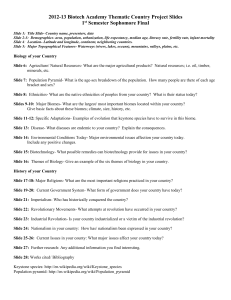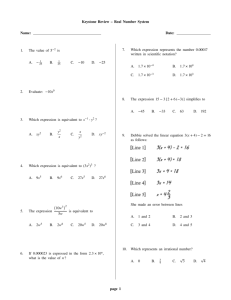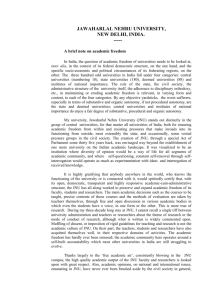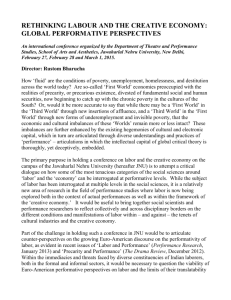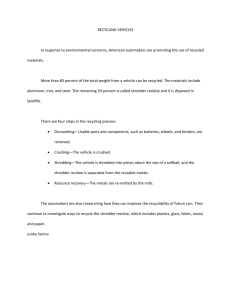A General Model for Preferential Hetero-oligomerization of LIN
advertisement
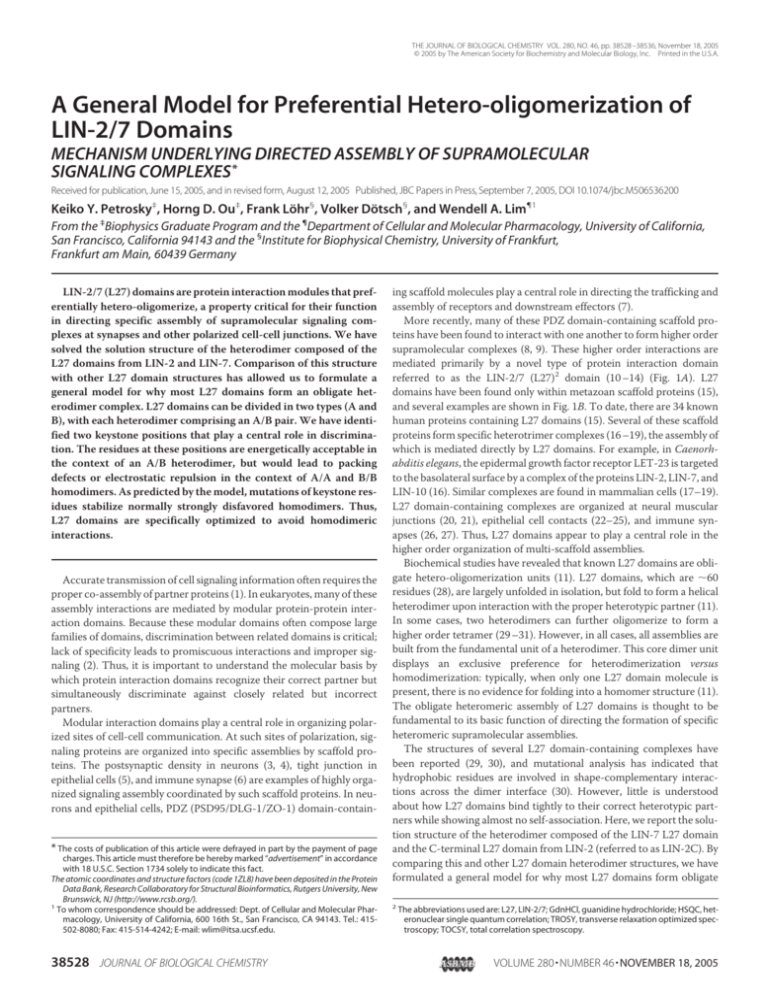
THE JOURNAL OF BIOLOGICAL CHEMISTRY VOL. 280, NO. 46, pp. 38528 –38536, November 18, 2005
© 2005 by The American Society for Biochemistry and Molecular Biology, Inc. Printed in the U.S.A.
A General Model for Preferential Hetero-oligomerization of
LIN-2/7 Domains
MECHANISM UNDERLYING DIRECTED ASSEMBLY OF SUPRAMOLECULAR
SIGNALING COMPLEXES *
Received for publication, June 15, 2005, and in revised form, August 12, 2005 Published, JBC Papers in Press, September 7, 2005, DOI 10.1074/jbc.M506536200
Keiko Y. Petrosky‡, Horng D. Ou‡, Frank Löhr§, Volker Dötsch§, and Wendell A. Lim¶1
From the ‡Biophysics Graduate Program and the ¶Department of Cellular and Molecular Pharmacology, University of California,
San Francisco, California 94143 and the §Institute for Biophysical Chemistry, University of Frankfurt,
Frankfurt am Main, 60439 Germany
LIN-2/7 (L27) domains are protein interaction modules that preferentially hetero-oligomerize, a property critical for their function
in directing specific assembly of supramolecular signaling complexes at synapses and other polarized cell-cell junctions. We have
solved the solution structure of the heterodimer composed of the
L27 domains from LIN-2 and LIN-7. Comparison of this structure
with other L27 domain structures has allowed us to formulate a
general model for why most L27 domains form an obligate heterodimer complex. L27 domains can be divided in two types (A and
B), with each heterodimer comprising an A/B pair. We have identified two keystone positions that play a central role in discrimination. The residues at these positions are energetically acceptable in
the context of an A/B heterodimer, but would lead to packing
defects or electrostatic repulsion in the context of A/A and B/B
homodimers. As predicted by the model, mutations of keystone residues stabilize normally strongly disfavored homodimers. Thus,
L27 domains are specifically optimized to avoid homodimeric
interactions.
Accurate transmission of cell signaling information often requires the
proper co-assembly of partner proteins (1). In eukaryotes, many of these
assembly interactions are mediated by modular protein-protein interaction domains. Because these modular domains often compose large
families of domains, discrimination between related domains is critical;
lack of specificity leads to promiscuous interactions and improper signaling (2). Thus, it is important to understand the molecular basis by
which protein interaction domains recognize their correct partner but
simultaneously discriminate against closely related but incorrect
partners.
Modular interaction domains play a central role in organizing polarized sites of cell-cell communication. At such sites of polarization, signaling proteins are organized into specific assemblies by scaffold proteins. The postsynaptic density in neurons (3, 4), tight junction in
epithelial cells (5), and immune synapse (6) are examples of highly organized signaling assembly coordinated by such scaffold proteins. In neurons and epithelial cells, PDZ (PSD95/DLG-1/ZO-1) domain-contain-
* The costs of publication of this article were defrayed in part by the payment of page
charges. This article must therefore be hereby marked “advertisement” in accordance
with 18 U.S.C. Section 1734 solely to indicate this fact.
The atomic coordinates and structure factors (code 1ZL8) have been deposited in the Protein
Data Bank, Research Collaboratory for Structural Bioinformatics, Rutgers University, New
Brunswick, NJ (http://www.rcsb.org/).
1
To whom correspondence should be addressed: Dept. of Cellular and Molecular Pharmacology, University of California, 600 16th St., San Francisco, CA 94143. Tel.: 415502-8080; Fax: 415-514-4242; E-mail: wlim@itsa.ucsf.edu.
38528 JOURNAL OF BIOLOGICAL CHEMISTRY
ing scaffold molecules play a central role in directing the trafficking and
assembly of receptors and downstream effectors (7).
More recently, many of these PDZ domain-containing scaffold proteins have been found to interact with one another to form higher order
supramolecular complexes (8, 9). These higher order interactions are
mediated primarily by a novel type of protein interaction domain
referred to as the LIN-2/7 (L27)2 domain (10 –14) (Fig. 1A). L27
domains have been found only within metazoan scaffold proteins (15),
and several examples are shown in Fig. 1B. To date, there are 34 known
human proteins containing L27 domains (15). Several of these scaffold
proteins form specific heterotrimer complexes (16 –19), the assembly of
which is mediated directly by L27 domains. For example, in Caenorhabditis elegans, the epidermal growth factor receptor LET-23 is targeted
to the basolateral surface by a complex of the proteins LIN-2, LIN-7, and
LIN-10 (16). Similar complexes are found in mammalian cells (17–19).
L27 domain-containing complexes are organized at neural muscular
junctions (20, 21), epithelial cell contacts (22–25), and immune synapses (26, 27). Thus, L27 domains appear to play a central role in the
higher order organization of multi-scaffold assemblies.
Biochemical studies have revealed that known L27 domains are obligate hetero-oligomerization units (11). L27 domains, which are ⬃60
residues (28), are largely unfolded in isolation, but fold to form a helical
heterodimer upon interaction with the proper heterotypic partner (11).
In some cases, two heterodimers can further oligomerize to form a
higher order tetramer (29 –31). However, in all cases, all assemblies are
built from the fundamental unit of a heterodimer. This core dimer unit
displays an exclusive preference for heterodimerization versus
homodimerization: typically, when only one L27 domain molecule is
present, there is no evidence for folding into a homomer structure (11).
The obligate heteromeric assembly of L27 domains is thought to be
fundamental to its basic function of directing the formation of specific
heteromeric supramolecular assemblies.
The structures of several L27 domain-containing complexes have
been reported (29, 30), and mutational analysis has indicated that
hydrophobic residues are involved in shape-complementary interactions across the dimer interface (30). However, little is understood
about how L27 domains bind tightly to their correct heterotypic partners while showing almost no self-association. Here, we report the solution structure of the heterodimer composed of the LIN-7 L27 domain
and the C-terminal L27 domain from LIN-2 (referred to as LIN-2C). By
comparing this and other L27 domain heterodimer structures, we have
formulated a general model for why most L27 domains form obligate
2
The abbreviations used are: L27, LIN-2/7; GdnHCl, guanidine hydrochloride; HSQC, heteronuclear single quantum correlation; TROSY, transverse relaxation optimized spectroscopy; TOCSY, total correlation spectroscopy.
VOLUME 280 • NUMBER 46 • NOVEMBER 18, 2005
A Model for Preferential L27 Domain Hetero-oligomerization
FIGURE 1. Domain architecture and interactions
of L27 domain-containing scaffold proteins. A,
a set of four L27 domains (boxed) mediate formation of a conserved heterotrimeric assembly of
PDZ domain-containing membrane-associated
guanylate kinase scaffold proteins that organize
signaling complexes at cell-cell junctions. Arrows
indicate specific interactions between L27
domains. The PDZ domains participate in interactions with receptors, signaling molecules, and
cytoskeletal proteins. B, examples of L27 domaincontaining proteins. SH3, Src homology-3 domain;
GK, guanylate kinase domain; CAMKII-like, calcium/calmodulin-dependent protein kinase II-like
domain.
heterodimers. L27 domains can be divided in two types, referred to as A
and B (29), with each heterodimer comprising an A/B pair. We have
identified two keystone positions that play a central role in discrimination between heterodimer and homodimer formation. The residues at
these positions are energetically acceptable in the context of an A/B
heterodimer, but would be destabilizing in the context of a hypothetical
A/A or B/B homodimer, leading to packing defects or electrostatic
repulsion. As predicted by the model, mutation of these keystone positions increases the stability of the normally strongly disfavored
homodimers. Thus, L27 domains are specifically optimized by negative
design: they are simultaneously optimized to maximize heterotypic
complementarity and to avoid homotypic interactions.
MATERIALS AND METHODS
Cloning and Expression of Linked L27 Domains—DNA regions
encoding L27 domains were amplified by PCR (11). The regions cloned
comprised C. elegans LIN-7A amino acids 115–180 (referred to as
LIN-7) and H. sapiens LIN-2 amino acids 394 – 460 (referred to as LIN2C). The mixed species LIN-7/LIN-2C pair (C. elegans/Homo sapiens)
was previously shown to be particularly stable (11) and best suited for
structural analysis.
L27 domains from LIN-7 and LIN-2C were expressed as a linked
construct to ensure a 1:1 ratio and to improve solubility, a technique
previously used to express the SAP97/LIN-2N L27 domain pair (29).
PCR primers where used to engineer a Gly-Ser linker between the two
L27 domains. The coding fragments were ligated into the expression
vector pBH4, which provided an N-terminal His6 tag for purification.
All constructs were verified by sequencing on both strands. The LIN-7
L27 domain construct has been described previously (11). Keystone
residues were mutated by QuikChange site-directed mutagenesis.
Protein constructs were expressed in Escherichia coli strain BL21
pLysS (Invitrogen). Cultures were grown in standard Luria broth at
32 °C and induced with 1 mM isopropyl 1-thio--D-galactopyranoside at
A600 nm ⬃ 0.8. To obtain labeled protein constructs (15N, 13C, and
13 15
C, N; 70% deuterated) for NMR analysis, cultures were transferred to
M9 minimal medium containing labeled 15NH4Cl and/or [13C6]glucose
before induction. Unlabeled protein constructs were harvested by cen-
NOVEMBER 18, 2005 • VOLUME 280 • NUMBER 46
trifugation after 3 h of growth, whereas labeled protein constructs were
harvested after 5 h. Cell pellets were resuspended in ⬃25 ml of lysis
buffer (50 mM Tris-Cl (pH 7.5) and 400 mM NaCl) per original liter of
culture and subjected to freeze-thaw treatment. Cell suspensions were
lysed by sonication and cleared by centrifugation at 15,000 ⫻ g. Wildtype and mutant constructs were expressed at similar levels.
The His6 tag-containing proteins were purified under native conditions by nickel-nitrilotriacetic acid affinity chromatography (Qiagen
Inc.). For NMR analysis, purified protein was dialyzed in 20 mM HEPES
(pH 8.0) and 0.5 mM tris(2-carboxyethyl)phosphine hydrochloride for
constructs containing cysteines, concentrated, and stored at ⫺80 °C
until used. For CD experiments, protein was stored in 50 mM phosphate
buffer (pH 7.5), 10 mM NaCl, and 1 mM tris(2-carboxyethyl)phosphine
hydrochloride for constructs containing cysteines.
NMR Structure Determination and Analysis—NMR experiments
were carried out at 25 °C on Bruker DRX500, DMX600, and Avance 700
spectrometers equipped with conventional 1H{13C/15N} triple resonance probes and on Bruker DRX600, Avance800, and Avance900 spectrometers equipped with cryogenic 1H{13C/15N} probes. Samples contained 2 mM protein in 90% H2O and 10% D2O with 20 mM HEPES (pH
8.0), 5 mM tris(2-carboxyethyl)phosphine hydrochloride, 0.05% 2,2dimethylsilapentane-5-sulfonic acid, and 0.05% sodium azide.
Signal dispersion of the constructs was verified with 15N heteronuclear single quantum correlation spectroscopy (HSQC) spectra.
Sequential backbone assignments were derived from transverse relaxation optimized spectroscopy (TROSY)-type three-dimensional heteronuclear correlation experiments, including HNCO, HN(CA)CO,
HN(CO)CACB, and HNCACB (32). Side chains were assigned through
a combination of total correlation spectroscopy (TOCSY)-[15N,1H]TROSY, (H)CC(CO)NH and HCC(CO)NH spectra (32). Distance constraints were derived from nuclear Overhauser effect correlation spectroscopy (NOESY)-[15N,1H]-TROSY, two types of NOESY-[13C,1H]HSQC experiments optimized for CH3 groups and aliphatic CH/CH2
groups and a constant time NOESY-[13C,1H]-TROSY with mixing
times ranging 70 to 120 ms (32).
Spectra were processed using XWIN-NMR (Bruker BioSpin Corp.)
and analyzed using XEASY (34). Chemical shifts were referenced to
JOURNAL OF BIOLOGICAL CHEMISTRY
38529
A Model for Preferential L27 Domain Hetero-oligomerization
FIGURE 2. NMR structure of the LIN-7/LIN-2C L27
domain dimer. A, wall-eye stereo diagram showing 10 superimposed NMR-derived structures; B,
structural statistics. RMSD, root mean square
deviation.
2,2-dimethylsilapentane-5-sulfonic acid. Backbone dihedral angle
restraints were derived from N, HN, C-␣, and C- chemical shifts with
the program TALOS (35). Structures were iteratively refined using the
simulated annealing protocol of the torsion angle dynamics program
DYANA (36). Nuclear Overhauser effect peak intensities were converted into upper distance bounds with the CALIBA function of
DYANA. Of the final 100 structures calculated, the 10 conformers with
the lowest target function values were selected for analysis. These structures were averaged, and the resulting structure was minimized in CNS
(37) using conjugate gradient minimization. The resulting 10 best structures were assessed for overall quality using PROCHECK (see Fig. 2)
(38). The coordinates have been deposited in the Protein Data Bank
(code 1ZL8). The residues in the Protein Data Bank file (Leu5–Tyr53
from the L27 domain of LIN-7 and Ser6–Ala59 from the C-terminal
domain of LIN-2) correspond to the numbering in Fig. 3. Note that
residues not observed by NMR are not included in the Protein Data
Bank file. Figures were generated using MolMol (39) and PyMOL (40).
Contact maps were generated using CNS.
Circular Dichroism—CD spectroscopy was performed on a Jasco 715
spectropolarimeter. All scans were performed in a 1-cm quartz cuvette
in 50 mM sodium phosphate buffer (pH 7.5), 10 mM NaCl, and 1 mM
tris(2-carboxyethyl)phosphine hydrochloride for constructs containing
cysteines. The CD spectra shown are the averages of two experiments.
Data for wavelength scans were collected at 1-nm intervals with 1-s
averaging time/data point and a total of 10 repetitions/scan. Data for
guanidine hydrochloride (GdnHCl) denaturation studies were collected
at 222 nm with 0.1 M denaturant intervals and with 60-s averaging
time/data point and 60-s equilibration time/data point. Identical results
were obtained with the wild-type protein for longer equilibration times
(data not shown). Both orientations of linked domains were found to
38530 JOURNAL OF BIOLOGICAL CHEMISTRY
behave identically in denaturant melts (data not shown). The midpoint
of the unfolding transition is concentration-independent above 4 M for
the wild-type construct (data not shown). For all experiments, the total
L27 domain concentration was 10 M (10 M monomers and 5 M
linked heterodimer).
RESULTS
Structure of the LIN-7/LIN-2C L27 Domain Heterodimer—The
structure of the LIN-7/LIN-2C heterodimer was solved by NMR as
shown in Fig. 2. The two domains are expressed in a single covalently
linked protein that yields improved expression and provides a 1:1 stoichiometry while not perturbing the structure of the complex (31). The
unlinked LIN-7䡠LIN-2C complex was previously shown to exist primarily as a dimer (11). When covalently linked, the apparent molecular mass
of the complex doubles (data not shown), consistent with formation of
a tetramer at NMR and CD concentrations. A similar tetramer structure
has recently been reported for a LIN-7䡠LIN-2C complex from mouse
(31). The tetramer interface is discussed elsewhere in great detail (29,
31); here, we focused primarily on the interaction specificity within the
core heterodimer unit.
The structure of the core heterodimer is similar to those of the previously solved L27 domain heterodimers, those involving SAP97/
LIN-2N (29) and PATJ/PALS1N (30). (LIN-2 and PALS1 scaffold proteins each contain two L27 domains; the “N” indicates that these
structures contain the N-terminal L27 domain.) Each individual monomer contains three ␣-helices, with the first two helices from each monomer packing together to form a four-helix bundle that forms the core
of the dimer. The third helices from the two monomers pack against one
another and the bottom of the helical bundle, capping the hydrophobic
core presented by the bundle. The overall heterodimer structure buries
VOLUME 280 • NUMBER 46 • NOVEMBER 18, 2005
A Model for Preferential L27 Domain Hetero-oligomerization
FIGURE3.SequencedivergencebetweenA-andB-typeL27domains.A,L27domainsequencesclusterintoA-andB-typedomainsbysequencehomology;B,sequencealignmentofA-andB-type
domains.Wehaveidentifiedtwodifferentiating”keystone“positions.Atthe”electrostatic“keystoneposition,A-typedomainsgenerallyhaveapositivelychargedresidue(⫹),whereasB-typedomains
have a negatively charged residue (⫺). A subclass of A-type domains (SAP97 family members) have a neutral residue (N), the implications of which are reviewed under ”Discussion.“ At the ”hydrophobic/polar“ keystone position, A-type domains have a conserved hydrophobic residue (H), which is polar in the B-type domains (P).
NOVEMBER 18, 2005 • VOLUME 280 • NUMBER 46
JOURNAL OF BIOLOGICAL CHEMISTRY
38531
A Model for Preferential L27 Domain Hetero-oligomerization
FIGURE 4. Conserved structural asymmetry in
the L27 domain A/B heterodimer. A, structures
of L27 domain heterodimers. The reported PATJ/
PALS1N (Protein Data Bank code 1VF6) and
SAP97/LIN-2N (code 1RSO) structures are tetrameric (dimer of a heterodimer). Only one heterodimer is shown: chains A and C are shown for
the PATJ/PALS1N heterodimer, and chains A and B
are shown for the SAP97/LIN-2N heterodimer. B,
alignments of L27 domain heterodimers and individual monomers. Contact maps are shown of the
PATJ/PALS1N heterodimer and individual monomers. Similar maps were observed for the other
L27 domains. A 6-Å cutoff was used for contacts
between C-␣. Helices A3 and B3 adopt distinct
conformations with respect to the central four-helix bundle: helix B3 makes more extensive contacts
with helices A2 and B1.
a surface area of 2159 Å2, 69% of which is due to the packing interface of
the central four-helix bundle.
L27 Domains Fall into Two Distinct Sequence Types—When aligned,
all known L27 domain sequences segregate into two distinct types,
referred to as A and B (29). The clustering of these two types is shown in
a dendrogram and by sequence alignment in Fig. 3 (A and B). Strikingly,
each pair of known interacting L27 domains involves the interaction of
an A-type monomer with a B-type monomer (10 –14). Not only are
most monomers unable to self-associate, but they are also unable to
interact with distinct monomers from within the same type (11, 12, 14).
In the case of the LIN-7/LIN-2C heterodimer studied here, LIN-7 is the
A-type monomer, whereas LIN-2C is a B-type monomer.
Conserved Structural Asymmetry in L27 Domain Dimers—A comparison of the three known L27 domain dimer structures is shown in
Fig. 4A. These structures align well (LIN-7/LIN-2C versus PATJ/
PALS1N root mean square deviation (C-␣) ⫽ 2.17 Å and LIN-7/LIN-2C
versus SAP97/LIN-2N root mean square deviation (C-␣) ⫽ 3.45 Å) only
when the same monomer subtypes are aligned (Fig. 4B). The other
chains in the tetramer structures are similarly aligned. Careful examination revealed that there are distinct asymmetries between the A- and
B-type monomer structures that are conserved across all known structures (31). Several key asymmetric features are highlighted in the contact maps shown in Fig. 4B. For the individual monomer units, in the
B-type monomer, helix B1 and B3 come into close contact, whereas in
the A-type monomer, helix A1 and A3 do not. In the dimer structure,
helix B3 comes within 6 Å of helix A2, whereas helix A3 does not come
closer than 10 Å to helix B2. These asymmetries can be understood by
examining the overall dimer structure (Fig. 4A). Although helices A3
and B3 function together to cap the bottom end of the central four-helix
bundle, helix B3 packs directly against the base of the bundle. In contrast, helix A3 primarily packs against helix B3.
38532 JOURNAL OF BIOLOGICAL CHEMISTRY
Keystone Positions: Potential Determinants of A- and B-type Monomer Structural Identity—The well conserved structural asymmetry
between A- and B-type monomers in three different L27 domain dimer
structures suggests that there is a fundamental difference in monomer
sequence that results in these clear structural differences. Thus, we
carefully examined the sequences of A and B subtypes for potential
keystone positions that are distinct in each type. Two strong candidate
positions emerged. First, the third residue in helix 2 has distinct electrostatic properties; in A-type monomers, this residue is either positively
charged or neutral, whereas in B-type monomers, it is almost always
negatively charged. Additionally, the second residue in helix 3 has distinct hydrophobic versus polar character; in A-type monomers, this
position is always a large hydrophobic residue, whereas in B-type monomers, it is a polar residue. These potential keystone positions are highlighted in the alignment shown in Fig. 3B. In the following two sections,
we examine how these two keystone positions might contribute to preferential heterodimerization.
The Hydrophobic/Polar Keystone Position—The second residue in
helix 3 is generally a large hydrophobic residue (Phe, Leu, or Met) in
A-type L27 domains, whereas it is almost always a polar residue (His,
Asp, or Ser) in B-type L27 domains (Fig. 3). Examination of L27 domain
dimer structures revealed that this position is at the center of the conserved structural asymmetry. Helix A3 adopts a different orientation
compared with helix B3 with respect to the main four-helix bundle.
Because of this different orientation, as shown in Fig. 5A, the second
residue in helix A3 (e.g. Phe41 in LIN-7) points into the core of the
protein, whereas the second residue in helix B3 (e.g. His39 in LIN-2C)
points toward the solvent. Thus, a possible model is that, to satisfy
packing and hydrophobicity requirements, this position must be a
hydrophobic residue in the A-type monomer, whereas the identity in
the B-type monomer is not critical.
VOLUME 280 • NUMBER 46 • NOVEMBER 18, 2005
A Model for Preferential L27 Domain Hetero-oligomerization
FIGURE 5. Mutational analysis of the hydrophobic/polar keystone position. A, the keystone residues at the beginning of helix 3 lie in different environments in the A- and B-type
monomers (LIN-7/LIN-2C structure shown). The polar residue His39 in the B-type monomer points away from the protein core, whereas the hydrophobic residue Phe41 in the A-type
monomer points into the central hydrophobic core formed by the four-helix bundle. B, the CD spectrum of the wild-type (wt) linked LIN-7/LIN-2C heterodimer indicates high helical
content (—). Mutation of the polar residue to a hydrophobic residue (LIN-2C H39F; - - - - ) had little effect on structure, whereas mutation of the hydrophobic residue to a polar residue
(LIN-7 F41H; 䡠䡠䡠䡠) resulted in a significant loss of helical signal. Swapping hydrophobic and polar positions partially restored helical signal (LIN-7 F41H and LIN-2C H39F; – – –). C, GdnHCl
(GuHCl) denaturation curves show that the polar-to-hydrophobic mutant (H39F; 䡺) was only mildly destabilized, whereas the hydrophobic-to-polar mutant (F41H; ●) failed to show
a cooperative unfolding transition. D, swapping hydrophobic and polar positions restored significant stability (LIN-7 F41H and LIN-2C H39F; 〫). deg, degrees.
To test this model, we mutated these two positions in the context of
a linked LIN-7/LIN-2C construct (A/B) (Fig. 5, B–D). The wild-type
construct showed a highly helical CD spectrum and a cooperative
GdnHCl denaturation transition, indicative of a well folded protein.
However, when Phe41 in the A-type monomer was mutated to histidine,
the protein was destabilized, and helical structure was lost. In contrast,
when His39 in the B-type monomer was mutated to phenylalanine, there
was minimal loss in stability. In addition, the mutation of this keystone
residue in the PALS1 C-terminal L27 domain (B type) to another polar
residue is functionally neutral (10). Thus, the keystone position must be
hydrophobic in the A-type monomer (buried), whereas either a hydrophobic or polar residue can be tolerated in the B-type monomer (surface). Interestingly, although the F41H (A-type monomer) mutation is
unstable, combining this with an additional mutation of H39F (B-type
monomer) led to a stable construct. This finding suggests that there is
not an absolute requirement that this position in the A-type monomer
be hydrophobic, but rather that at least one of the positions in either the
A- or B-type monomer must be hydrophobic to complete packing of the
core.
The Electrostatic Keystone Position—The third residue in helix A2 is
almost always positively charged (Lys), whereas the equivalent residue
in helix B2 is almost always negatively charged (Asp or Glu) (Fig. 3).
Examination of the structures revealed that these partially solvent-exposed keystone residues lie adjacent to the primarily hydrophobic interface between the two monomers as shown in Fig. 6A. Rather than interacting with each other, the keystone residues interact with
complementary charged surfaces in the opposite monomer. The positively charged keystone residue in helix A2 packs against a negatively
charged patch in helix B1 of the opposite monomer. Similarly, the negatively charged keystone residue in helix B2 lies adjacent to a positively
charged patch in helix A1. These complementary electrostatic patches
are present in all the L27 domain structures, although in each case, they
are composed of varying residues whose identities are not absolutely
conserved between L27 domains. Thus, in the context of A/B heterodimers, these keystone residues are found in a complementary electrostatic environment.
NOVEMBER 18, 2005 • VOLUME 280 • NUMBER 46
More important, if A/A or B/B homodimers were formed, these keystone residues would pack against a similarly charged patch (helix A2
with helix A1 and helix B2 with helix B1), resulting in a repulsive interaction. Thus, these keystone residues and their complementary electrostatic patch might make a significant contribution to preventing
homodimer formation.
To examine the effect of these charged keystone residues on stabilization of the A/B heterodimer and destabilization of potential A/A and
B/B homodimers, we mutated these residues in the context of the linked
LIN-7/LIN-2C construct. The keystone residues were mutated to either
an uncharged residue or a residue of opposite charge. If the charge
interaction is critical for stabilizing the heterodimer, then mutation to
either a neutral or oppositely charged residue will be highly destabilizing. If the primary role of the residue is to prevent potential homodimerization through charge repulsion, then one would expect to see dramatic destabilization only when these keystone residues are mutated to
the opposite charge (i.e. if they are mutated to look more like a
homodimeric partner), whereas a neutral residue would be tolerated.
The third residue in helix A2 of LIN-7 (residue 29 in the A-type
monomer) is normally lysine. When Lys29 was mutated to a neutral
residue, glutamine (Fig. 6B), the protein displayed mild destabilization.
However, more significant destabilization (reduced helicity and unfolding at lower denaturant concentrations) was observed when Lys29 was
mutated to aspartate (swapping its identity with that of the equivalent
keystone residue in a B-type monomer). The K29D mutant showed
behavior that began to approach that of an A/A homodimer pair: the CD
signal under basal conditions was reduced, and the unfolding transition
midpoint and sharpness were reduced.
The third residue in helix B2 of LIN-2 (residue 27 in the B-type monomer) is normally aspartate. When Asp27 was mutated to a neutral
residue, asparagine (Fig. 6C), the protein folding and stability were
mildly reduced. A more significant destabilization was observed with
mutation of Asp27 to a positively charged residue, lysine, which made it
mimic the keystone residue in an A-type monomer. The D27K mutant
approached the B/B homodimer pair, showing effects similar to those
observed with the K29D charge reversal mutation discussed above.
JOURNAL OF BIOLOGICAL CHEMISTRY
38533
A Model for Preferential L27 Domain Hetero-oligomerization
FIGURE 6. Mutational analysis of the electrostatic keystone position. A, surface electrostatic
potentials are shown for the four-helix bundle of
two L27 domain heterodimers. This is the top view,
looking down the axis of the four-helix bundle; the
monomers were pulled apart to view the interface.
Electrostatic keystone residues in helices A2 and
B2 (LIN-7 Lys29 and LIN-2C Asp27 or PATJ Lys34 and
PALS1N Asp32) interact with complementary
charged surfaces on helices B1 and A1, respectively. In principle, homodimerization would lead
to repulsive interactions. B, GdnHCl denaturation
curves show that mutation of the positively
charged keystone residue in the A-type monomer
to a neutral residue (LIN-7 K29Q; E) led to small
decrease in stability; mutation to an oppositely
charged residue (K29D; ●) led to more significant
destabilization. C, mutation of the negatively
charged keystone residue in the B-type monomer
to a neutral residue (LIN-2C D27N; 䡺) led to a small
decrease in heterodimer stability; mutation to an
oppositely charged residue (D27K; f) led to more
significant destabilization. D, the CD spectra show
that LIN-7 alone has low helical content (䡠䡠䡠䡠),
whereas mutation of the positively charged keystone residue to an oppositely charge residue
(K29D; ●) or a neutral residue (K29Q; E) increased
helical content close to that of the completely
folded wild-type (wt) A/B heterodimer (OO). E,
LIN-7 alone does not show a cooperative GdnHCl
unfolding transition (䡠䡠䡠䡠). Mutation of the keystone
residue to an oppositely charged residue (K29D;
●) or a neutral residue (K29Q; E) yielded proteins
showing significantly more cooperative unfolding
transitions. The unfolding transition for the linked
A/B heterodimer (OO) is shown for reference. For
all of these experiments, the total L27 domain concentration was 10 M (10 M monomers and 5 M
linked heterodimer). deg, degrees.
Together, these mutational results indicate that the electrostatic keystone residues make two contributions. The residues make a minor
contribution to stabilizing the heterodimer, presumably through favorable electrostatic interactions. However, they make a more significant
contribution to destabilizing potential homodimer formation via electrostatic repulsion.
As the residues composing the complementary electrostatic patch
are not conserved between subclasses within the A- or B-types, these
positions may be involved in further determining specificity within A
and B subclasses. Mutations to neutral or opposite charge were destabilizing (data not shown). However, because these mutations may have
destabilized the protein for reasons other than the complementarykeystone interactions, we addressed the importance of the electrostatic
keystone position by designing a mutant predicted to stabilize
homodimer formation.
Artificial Stabilization of Homodimers—These data support a model
in which the electrostatic keystone residues play a key role in determining the relative stabilities of heterotypic versus homotypic dimers. A
prediction of the model is that specific mutations of the keystone residues may allow for formation of stable homodimers. In our model, the
homodimer association between two LIN-7 L27 domains is disfavored
by repulsion between the positively charged residue (lysine) in the keystone position and the similarly positively charged surface on helix A1,
surfaces that would come into contact in a putative homodimer
(Fig. 6A).
Our model predicts that mutation of the keystone lysine to a negative
or neutral residue should stabilize homodimer formation. To test this,
we worked with a single A-type L27 domain (unlinked) from LIN-7 and
mutated its electrostatic keystone residue (Lys29) to aspartic acid or
glutamine. We observe several pieces of evidence indicating stabiliza-
38534 JOURNAL OF BIOLOGICAL CHEMISTRY
tion of a folded homomer structure (Fig. 6, D and E). First, the mutant
LIN-7 L27 domains showed a dramatic increase in helical content by
CD. Second, the mutant L27 domains showed a cooperative GdnHCl
unfolding transition. Although this transition was not as sharp as with a
native heterodimer pair, it was significantly more cooperative than the
transition of the wild-type LIN-7 monomer. The observation that both
the neutral substitution (K29Q) and the charge swap substitution
(K29D) caused similar increases in stability suggests that removing the
repulsive interaction is energetically more critical than potentially creating a stabilizing salt bridge (41).
DISCUSSION
A General Model for Preferential Heterotypic L27 Domain Assembly:
Importance of Negative Design—The analysis and experiments
described here support a model of L27 domain assembly in which heterotypic dimer formation is favored, not simply because of high complementarity between heterotypic monomers, but also because of strong
repulsion between homotypic monomers. As shown in Fig. 7, there are
two keystone positions in each monomer that determine monomer
type. One keystone residue, at the beginning of helix 2, is electrostatic: in
A-type monomers, it is positively charged, whereas in B-type monomers, it is negatively charged. The second keystone residue, at the beginning of helix 3, can pack into the core at the base of the helical bundle: in
A-type monomers, it is hydrophobic, whereas in B-type monomers, it is
polar.
Two types of interactions determine whether a dimer complex will be
stable. First, the electrostatic keystone residue must be complementary
in charge to the surface on helix 2 of the partner monomer. A and B
partners display the proper complementarity; however, A/A or B/B
partners would be repulsive. As predicted, when charge swap mutations
VOLUME 280 • NUMBER 46 • NOVEMBER 18, 2005
A Model for Preferential L27 Domain Hetero-oligomerization
FIGURE 7. General model for how L27 domain
keystone positions favor formation of heterotypic dimers, but disfavor homodimers. The
schematics show how two L27 domain monomers
pack against one another to form a dimer. A, stable
heterodimers have complementary electrostatic
surfaces on helices 1 and 2 and have a hydrophobic residue at one of the keystone positions in helix
3, allowing for proper packing and closure of the
hydrophobic core. (The charge on helix 1 is not
conserved to one specific residue and is represented by a cloud indicating overall electrostatic
potential.) B, we postulate that A/A and B/B
homodimers are highly unstable because they
would have repulsive interactions at the helix
1-helix 2 interface and cannot fulfill packing
requirements.
are made at the electrostatic keystone residues in the context of the
normally interacting A/B heterodimer, the interaction is severely destabilized because this interface mimics the repulsive interaction that
would occur in a homodimer. Second, to properly cap the core of the
central four-helix bundle, there appears to be a strong preference for a
hydrophobic residue at one of the keystone residues at the beginning of
helix 3. In the case of A/B heterodimers, it is the A-type monomer that
always provides this large hydrophobic residue to complete packing of
the core; the B-type monomer consistently has a polar residue at this
position, leading to the conserved asymmetry in the A3 and B3 helix
positions.
A critical element of this model is that L27 domain interaction specificity is determined not only by positive interactions made in the preferred A/B heterodimers, but also by strong negative interactions that
would occur in the hypothetical A/A or B/B homodimers. We have been
able to make specific loss-of-charge mutations that yielded a significantly stabilized A/A homodimer. Thus, L27 domains appear to have
evolved through both positive and negative design to optimize obligate
heterotypic interactions. Such tight interaction differences are compatible with the general function of L27 domains as modules that direct the
assembly of large heteromeric supramolecular complexes.
The model presented here explains why the A and B types of L27
domains generally prefer heterotypic interactions; it does not explicitly
explain why, within the class of A- and B-type monomers, specific
domains preferentially interact with one another. Presumably, finer resolution interactions and differences between domains determine this
higher level of specificity. Moreover, recent studies have suggested that
domain-specific interactions formed in higher order tetrameric assemblies can play a role in specificity (31).
Avoidance of Intramolecular Interaction in Proteins Containing Multiple L27 Domains—Some proteins, including LIN-2 and its orthologs,
are observed to have two adjacent L27 domains. In all of these known
cases, the two domains are the B type (B/B). Each of these domains
mediates interaction with a distinct protein containing an A-type monomer. For proper assembly of the complex to take place, it may be
particularly important that the two L27 domains in the same protein do
not interact with one another, especially given their high effective concentration. Having two adjacent domains of the same type and having
NOVEMBER 18, 2005 • VOLUME 280 • NUMBER 46
such a strongly disfavored homodimeric interaction, especially between
B-type monomers, would prevent this potential competitive intramolecular association.
Homo-oligomerization of SAP97 Family L27 Domains—There is a
small subset of L27 domains (three in human) that appear to lack at least
one of the hallmark electrostatic keystone residues. The mammalian
protein SAP97 and its invertebrate ortholog, DLG, align with A-type
domains, but have a neutral residue at the normally positively charged
keystone residue at the beginning of helix 2 (Fig. 3B). In our model, loss
of this positively charged keystone residue would, in principle, increase
the stability of the normally unfavorable L27 domain homodimer.
Although the SAP97 L27 domain can form stable heterodimers with a
B-type L27 domain from LIN-2 (29), recent studies have indicated that
SAP97 and DLG proteins can also homo-oligomerize in an L27 domaindependent manner (42, 43). This unique property among L27 domains
is consistent with the rules for oligomerization presented here.
Heterotypic interactions of the SAP97 L27 domain are thought to be
important for proper trafficking of synaptic receptors (44), and
homodimeric interactions are thought to be important for proper functional assembly at synapses (42). Thus, the SAP97 family of L27 domains
appears to have evolved to minimize homodimeric repulsion to allow
the domains to participate in both homodimeric and heterodimeric
interactions, a feature unique to this L27 domain family.
Negative Design: Other Examples and Engineered Proteins—L27
domains appear to use a remarkably simple repulsive mechanism to
achieve high dimerization specificity. This type of negative design, the
introduction of potential repulsive interactions that would selectively be
made in an undesired complex, is observed in several other systems.
The importance of electrostatic repulsion in preventing L27 domain
homodimerization is very similar to that of the mechanism of preferential heterodimerization observed in certain coiled coils. For example,
the Fos leucine zipper does not form a stable homodimer, but instead
forms a tight heterodimer with the Jun leucine zipper (45). This preference is largely driven by electrostatic repulsive interactions that would
occur in a hypothetical Fos homodimer. In another example, artificial
coiled coils can be designed to selectively homo- or hetero-dimerize
according to negative selection against engineered interfaces with
JOURNAL OF BIOLOGICAL CHEMISTRY
38535
A Model for Preferential L27 Domain Hetero-oligomerization
repulsive charge interactions or unsatisfactory packing arrangements
(46).
Introducing interactions that are repulsive or destabilizing in the context of only one of several possible interaction states has been used to
greatly increase interaction specificity of engineered proteins (46, 47).
Negative design, as illustrated by L27 domains, is a powerful force in
optimizing protein-protein interaction specificity, whether achieved
through evolution or design.
REFERENCES
1.
2.
3.
4.
5.
6.
7.
8.
9.
10.
11.
12.
13.
14.
15.
16.
17.
18.
19.
20.
21.
22.
23.
Park, S. H., Zarrinpar, A., and Lim, W. A. (2003) Science 299, 1061–1064
Zarrinpar, A., Park, S. H., and Lim, W. A. (2003) Nature 426, 676 – 680
Kennedy, M. B. (1997) Trends Neurosci. 20, 264 –268
Garner, C. C., Nash, J., and Huganir, R. L. (2000) Trends Cell Biol. 10, 274 –280
Mitic, L. L., and Anderson, J. M. (1998) Annu. Rev. Physiol. 60, 121–142
Rudd, C. E. (1999) Cell 96, 5– 8
Harris, B. Z., and Lim, W. A. (2001) J. Cell Sci. 114, 3219 –3231
Dimitratos, S. D., Woods, D. F., Stathakis, D. G., and Bryant, P. J. (1999) BioEssays 21,
912–921
Rongo, C. (2001) Cytokine Growth Factor Rev. 12, 349 –359
Kamberov, E., Makarova, O., Roh, M., Liu, A., Karnak, D., Straight, S., and Margolis,
B. (2000) J. Biol. Chem. 275, 11425–11431
Harris, B. Z., Venkatasubrahmanyam, S., and Lim, W. A. (2002) J. Biol. Chem. 277,
34902–34908
Lee, S., Fan, S., Makarova, O., Straight, S., and Margolis, B. (2002) Mol. Cell. Biol. 22,
1778 –1791
Roh, M. H., Makarova, O., Liu, C. J., Shin, K., Lee, S., Laurinec, S., Goyal, M., Wiggins,
R., and Margolis, B. (2002) J. Cell Biol. 157, 161–172
Karnak, D., Lee, S., and Margolis, B. (2002) J. Biol. Chem. 277, 46730 – 46735
Schultz, J., Milpetz, F., Bork, P., and Ponting, C. P. (1998) Proc. Natl. Acad. Sci. U. S. A.
95, 5857–5864
Kaech, S. M., Whitfield, C. W., and Kim, S. K. (1998) Cell 94, 761–771
Jo, K., Derin, R., Li, M., and Bredt, D. S. (1999) J. Neurosci. 19, 4189 – 4199
Butz, S., Okamoto, M., and Sudhof, T. C. (1998) Cell 94, 773–782
Borg, J. P., Straight, S. W., Kaech, S. M., de Taddeo-Borg, M., Kroon, D. E., Karnak, D.,
Turner, R. S., Kim, S. K., and Margolis, B. (1998) J. Biol. Chem. 273, 31633–31636
Thomas, U., Kim, E., Kuhlendahl, S., Koh, Y. H., Gundelfinger, E. D., Sheng, M.,
Garner, C. C., and Budnik, V. (1997) Neuron 19, 787–799
Bachmann, A., Timmer, M., Sierralta, J., Pietrini, G., Gundelfinger, E. D., Knust, E.,
and Thomas, U. (2004) J. Cell Sci. 117, 1899 –1909
Hong, Y., Stronach, B., Perrimon, N., Jan, L. Y., and Jan, Y. N. (2001) Nature 414,
634 – 638
Bachmann, A., Schneider, M., Theilenberg, E., Grawe, F., and Knust, E. (2001) Nature
38536 JOURNAL OF BIOLOGICAL CHEMISTRY
414, 638 – 643
24. Shin, K., Straight, S., and Margolis, B. (2005) J. Cell Biol. 168, 705–711
25. Straight, S. W., Shin, K., Fogg, V. C., Fan, S., Liu, C. J., Roh, M., and Margolis, B. (2004)
Mol. Biol. Cell 15, 1981–1990
26. Ralston, K. J., Hird, S. L., Zhang, X., Scott, J. L., Jin, B., Thorne, R. F., Berndt, M. C.,
Boyd, A. W., and Burns, G. F. (2004) J. Biol. Chem. 279, 33816 –33828
27. Round, J. L., Tomassian, T., Zhang, M., Patel, V., Schoenberger, S. P., and Miceli, M. C.
(2005) J. Exp. Med. 201, 419 – 430
28. Doerks, T., Bork, P., Kamberov, E., Makarova, O., Muecke, S., and Margolis, B. (2000)
Trends Biochem. Sci. 25, 317–318
29. Feng, W., Long, J. F., Fan, J. S., Suetake, T., and Zhang, M. (2004) Nat. Struct. Mol.
Biol. 11, 475– 480
30. Li, Y., Karnak, D., Demeler, B., Margolis, B., and Lavie, A. (2004) EMBO J. 23,
2723–2733
31. Feng, W., Long, J. F., and Zhang, M. (2005) Proc. Natl. Acad. Sci. U. S. A. 102,
6861– 6866
32. Salzmann, M. W. G., Pervushin, K., Senn, H., and Wuthrich, K. (1999) J. Am. Chem.
Soc. 121, 844 – 848
33. Deleted in proof
34. Bartels, C., Xia, T., Billeter, M., Güntert, P., and Wüthrich, K. (1995) J. Biomol. NMR
6, 1–10
35. Cornilescu, G., Delaglio, F., and Bax, A. (1999) J. Biomol. NMR 13, 289 –302
36. Güntert, P., Mumenthaler, C., and Wüthrich, K. (1997) J. Mol. Biol. 273, 283–298
37. Brunger, A. T., Adams, P. D., Clore, G. M., DeLano, W. L., Gros, P., Grosse-Kunstleve,
R. W., Jiang, J. S., Kuszewski, J., Nilges, M., Pannu, N. S., Read, R. J., Rice, L. M.,
Simonson, T., and Warren, G. L. (1998) Acta Crystallogr. Sect. D Biol. Crystallogr. 54,
905–921
38. Laskowski, R. A., Rullmannn, J. A., MacArthur, M. W., Kaptein, R., and Thornton,
J. M. (1996) J. Biomol. NMR 8, 477– 486
39. Koradi, R., Billeter, M., and Wuthrich, K. (1996) J. Mol. Graph. 14, 51–55
40. DeLano, W. L. (2002) The PyMOL Molecular Graphics System, DeLano Scientific,
San Carlos, CA
41. Sheinerman, F. B., Norel, R., and Honig, B. (2000) Curr. Opin. Struct. Biol. 10,
153–159
42. Nakagawa, T., Futai, K., Lashuel, H. A., Lo, I., Okamoto, K., Walz, T., Hayashi, Y., and
Sheng, M. (2004) Neuron 44, 453– 467
43. Marfatia, S. M., Byron, O., Campbell, G., Liu, S. C., and Chishti, A. H. (2000) J. Biol.
Chem. 275, 13759 –13770
44. Leonoudakis, D., Conti, L. R., Radeke, C. M., McGuire, L. M., and Vandenberg, C. A.
(2004) J. Biol. Chem. 279, 19051–19063
45. O’Shea, E. K., Rutkowski, R., and Kim, P. S. (1992) Cell 68, 699 –708
46. Havranek, J. J., and Harbury, P. B. (2003) Nat. Struct. Biol. 10, 45–52
47. Kortemme, T., Joachimiak, L. A., Bullock, A. N., Schuler, A. D., Stoddard, B. L., and
Baker, D. (2004) Nat. Struct. Mol. Biol. 11, 371–379
VOLUME 280 • NUMBER 46 • NOVEMBER 18, 2005
